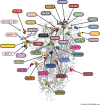Spike protein of SARS-CoV-2 variants: a brief review and practical implications
- PMID: 35397075
- PMCID: PMC8994061
- DOI: 10.1007/s42770-022-00743-z
Spike protein of SARS-CoV-2 variants: a brief review and practical implications
Abstract
The scientific community has been alarmed by the possible immunological evasion, higher infectivity, and severity of disease caused by the newest variants of SARS-CoV-2. The spike protein has an important role in the cellular invasion of viruses and is the target of several vaccines and therapeutic resources, such as monoclonal antibodies. In addition, some of the most relevant mutations in the different variants are on the spike (S) protein gene sequence that leads to structural alterations in the predicted protein, thus causing concern about the protection mediated by vaccines against these new strains. The present review highlights the most recent knowledge about COVID-19 and vaccines, emphasizing the different spike protein structures of SARS-CoV-2 and updating the reader about the emerging viral variants and their classifications, the more common viral mutations described and their distribution in Brazil. It also compiles a table with the most recent knowledge about all of the Omicron spike mutations.
Keywords: Brazil; COVID-19; Public health; SARS-CoV-2; Variants; Viral diseases.
© 2022. The Author(s) under exclusive licence to Sociedade Brasileira de Microbiologia.
Conflict of interest statement
The authors declare that they have no conflicts of interest.
Figures




References
Publication types
MeSH terms
Substances
Supplementary concepts
LinkOut - more resources
Full Text Sources
Miscellaneous

